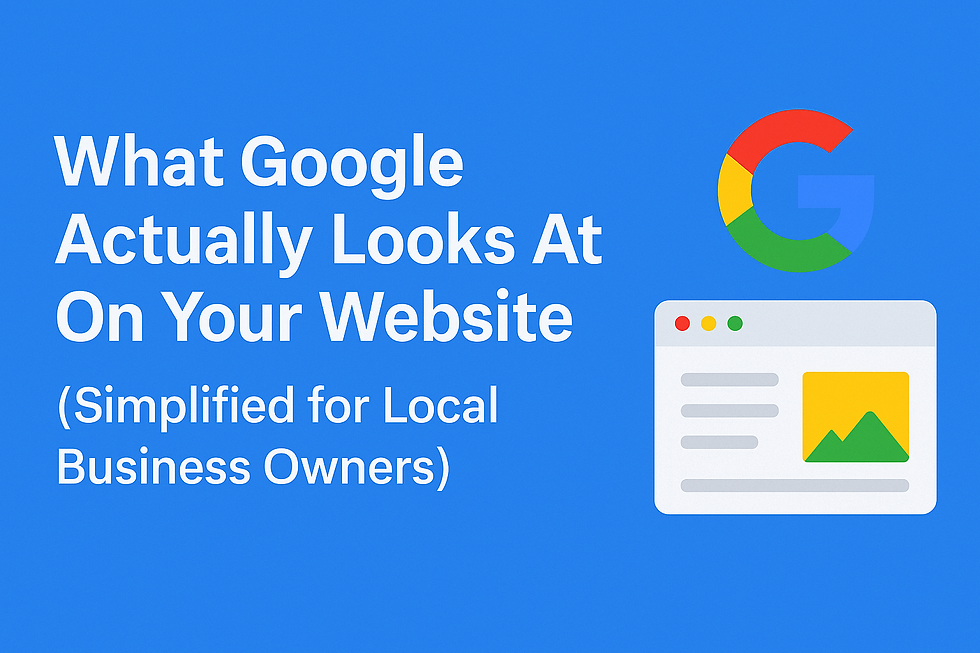What Google Actually Looks At On Your Website (Simplified for Local Business Owners)
- Johnathon Crowder
- Aug 2
- 5 min read

If you're a local business owner in Springfield, search engine optimization (SEO) can feel overwhelming—like it’s built for big companies with marketing teams and jargon-filled checklists.
But here’s the truth.
Google doesn’t rank based on who’s the biggest. It ranks based on who’s most helpful.
That means you, as a small business owner, can absolutely show up on the first page of results — if your website is built with the right signals.
This guide strips away the fluff and explains what Google actually looks at when ranking local websites — in plain English — so you can make smart improvements without needing to be a tech wizard.
✅ 1. Your Page Titles and Meta Descriptions
Why it matters:Your page title (also called the "title tag") is one of the strongest signals Google uses to understand what a page is about. It’s also what people see when your site appears in search results.
What to do:
Make every page have a unique title.
Use keywords that people are likely to search for, along with your city or service area.
Write a clear, benefit-driven meta description under 160 characters that encourages a click.
Example:
Title: “Springfield MO Roof Repair | Affordable, Fast Service”Meta: “Need fast, affordable roof repair in Springfield? Get a free quote today and protect your home.”
Pro Tip: Tools like Yoast SEO or Wix’s built-in SEO settings make editing these easy.
✅ 2. Headings and Page Structure (H1, H2, H3)
Why it matters: Google scans your headings to understand your content structure and relevance. So do your visitors.
What to do:
Use one H1 per page for your main headline. It should include your keyword or location.
Use H2s for main sections (like service categories) and H3s to break down steps or FAQs.
Make sure headings actually help people scan and understand what the page is about.
Bad: H1 says “Welcome!” or “Home Page”Good: H1 says “Professional Landscaping Services in Springfield, MO”
Formatting Tip: Proper heading structure also helps screen readers and improves accessibility.
✅ 3. Relevant, Helpful Content (No Fluff!)
Why it matters:Google wants to show users content that truly helps them solve a problem, answer a question, or make a decision.
What to do:
Write at least 300–800 words on each service page.
Use conversational language, not marketing jargon.
Address real questions and include your local service area in the copy.
Add real photos, FAQs, testimonials, and CTAs (calls to action).
Better content = better rankings.
Pro Tip: Include Springfield-specific mentions: landmarks, neighborhoods, zip codes, and nearby towns like Ozark or Nixa.
✅ 4. Mobile Speed and User Experience
Why it matters:Over 60% of local searches happen on phones. If your site is slow or hard to navigate, users bounce—and Google takes note.
What to do:
Use tools like PageSpeed Insights or GTmetrix to test your site.
Compress large images and videos.
Stick with simple fonts, clear buttons, and mobile-friendly layouts.
Avoid giant headers, popups, or slow-loading sliders.
Goal: Fast, smooth, tap-friendly design across all screen sizes.
✅ 5. Internal Linking (Connect Your Pages Together)
Why it matters:Google follows internal links to discover new pages and understand your website’s hierarchy.
What to do:
Link your homepage to every core service page.
Include links between blog posts and services.
Use anchor text that matches the topic (not just “click here”).
Example:
“Need roof repair? Check out our Springfield roof repair services.”
Bonus: Internal links also help reduce bounce rate by keeping visitors exploring your site.
✅ 6. Google Business Profile (Map Listings)
Why it matters:Showing up in the “Map Pack” is gold. But Google pulls info from both your website and your Google Business Profile.
What to do:
Claim and verify your GBP at google.com/business
Choose the right category and list all your services.
Add high-quality photos, your service area, and up-to-date hours.
Encourage reviews and respond to every one.
Pro Move: Post weekly updates or promotions. Google loves active businesses.
✅ 7. Quality Backlinks (Not Spam!)
Why it matters:When trustworthy sites link to your business, it tells Google your site is credible.
What to do:
Get listed on local directories: Yelp, BBB, Chamber of Commerce, etc.
Ask vendors, partners, or happy customers to link to your site.
Write helpful blog posts others might want to share.
Warning: Avoid buying backlinks from cheap “SEO services.” If it sounds sketchy, it probably is.
One good local backlink > 100 spammy ones.
✅ 8. Visitor Behavior (Click, Scroll, and Bounce Rates)
Why it matters: Google watches how users behave on your site. If people click and leave instantly, it signals that your content didn’t help them.
What to do:
Make the page engaging from the start (use clear headlines and benefits).
Include CTAs early and often.
Use testimonials, FAQs, trust badges, and local references to build confidence.
Guide them toward one clear next step (quote, call, schedule, etc.)
Pro Tip: Avoid giant blocks of text—break it up visually.
✅ 9. Image Alt Text (Accessibility + SEO Bonus)
Why it matters:Google can’t “see” your images unless you describe them—and this helps with both accessibility and SEO.
What to do:
Add alt text to every image.
Be descriptive and include the service + city if relevant.
Keep it natural (e.g., “New wood fence installed in Springfield backyard”).
✅ 10. Site Security and Technical Health
A secure, crawlable, error-free site keeps both visitors and Google happy.
What to do:
Make sure your site uses HTTPS (SSL certificate)
Fix any broken links (404 errors)
Submit your sitemap in Google Search Console
Avoid duplicate content and slow-loading plugins
Platforms like Wix, Webflow, and WordPress (with care) make this manageable.
Final Thoughts: SEO Isn’t About Tricks — It’s About Trust
At the end of the day, Google is trying to rank the most trustworthy, helpful, and relevant site for each search.
If your website is built for real humans—with fast loading, clear language, local relevance, and proof you do good work—Google will notice.
And if you’re unsure where to start or what’s helping vs hurting your current site?
Get a Free Website Audit That Shows Exactly What Google Sees
Let me take a look under the hood for you.
At Crowder Code and Design, I specialize in helping Springfield business owners:
Rank higher locally
Turn visitors into leads
Clean up outdated or confusing websites
Get a free custom video audit (no pressure or strings attached) showing:
What Google sees when it scans your site
Where your SEO signals are strong or weak
The quick fixes that can start helping this month




Comments